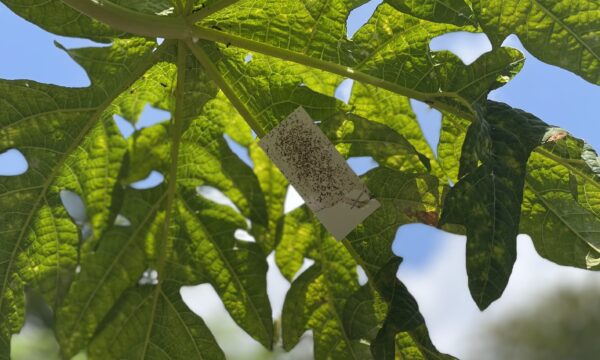
Aspergillus ear rot on corn. USDA APHIS PPQ Archive, Bugwood.org
Aspergillus flavus and A. parasiticus are important fungal pathogens that infect a wide range of cereals, oil seeds and nuts. They produce toxic metabolites called aflatoxins (mycotoxins with carcinogenic and teratogenic properties) that can contaminate food products. Although strictly regulated around the world, aflatoxin contamination in developing countries is poorly regulated. In addition, limited management options and lack of agricultural resources have led to repeated outbreaks of acute aflatoxicosis, fatal to many. Two recent studies on strains of A. flavus may provide a new route for aflatoxin management.
In corn, the crop associated with recent epidemics in Kenya (2010, 2008, 2004-2006), A. flavus infects kernels causing Aspergillus ear rot. This disease can be caused by two specific strains of A. flavus – strain S that produces fewer spores, but higher aflatoxin and strain L that produces more spores but less aflatoxin. In a recent study, researchers Probst et al. studied the relative percentage of these two strains in different parts of Kenya. They found that in regions where aflatoxicosis outbreaks occurred frequently, like in the Eastern province, S strain was predominant in soil and corn samples. In neighboring provinces without such outbreaks however, much lower incidence of S strain was found suggesting that community structure of A. flavus might be a crucial factor influencing aflatoxicosis outbreaks.
In another study, Probst et al. studied the potential of native atoxigenic (lacking the ability to produce aflatoxin) L strains to serve as biocontrol agents. They found that 12 of their 96 atoxigenic isolates were able to reduce aflatoxin production by > 80% in corn kernels inoculated with a highly toxogenic S strain. Although such biological control isolates are currently available in US, introducing exotic strains is considered risky for multiple reasons. Thus the identification of better adapted, native isolates could provide a viable solution to low-income farmers of Kenya where pre-harvest aflatoxin management options are lacking.
References:
- Probst, C.; Schulthess, F.; Cotty, P.J. (published online 7 July 2009) Impact of Aspergillus section Flavi community structure on the development of lethal levels of aflatoxins in Kenyan maize (Zea mays). Journal of Applied Microbiology. DOI: 10.1111/j.1365-2672.2009.04458.x
- Probst, C.; Bandyopadhyay, R.; Price, L.E.; Cotty, P.J. (February 2011) Identification of Atoxigenic Aspergillus flavus Isolates to Reduce Aflatoxin Contamination of Maize in Kenya. Plant Disease. DOI: 10.1094/PDIS-06-10-0438
1 Comment
Leave a Reply
Related News & Blogs
How do pest risk registers address the spread of plant pests in Africa?
Pest risk registers can help to solve problems in agriculture, addressing the growing global threat of plant pests. Moreover, changing weather patterns, led by rising temperatures, are causing them to reproduce faster and expand into new regions. In ad…
10 July 2025





[…] Mycotoxins produced by Aspergillus flavus and A. parasiticus (important fungal pathogens) can contaminate food products from various crops and be fatal to many. Without effective management practices being widely disseminated to farmers in the right format, outbreaks can occur frequently in developing countries and thus impact on human health. Extension materials are needed to provide farmers with effective management options in order to prevent the survival of fungal disease on crop debris and in soil which can lead to repeated outbreaks. Plantwise countries such as Malawi and Zambia have produced detailed factsheets and Pest Management Decisions Guides (PMDGs) ensuring that good pre- and post-harvest practices reach farmers via plant doctors. […]